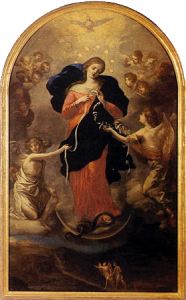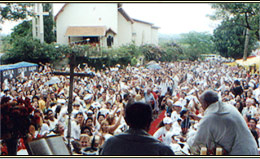Jesus’ mother approached him and said, “They have no more wine.” [John 2:3]
 Our Lady Undoer of Knots, by Johann Melchior Georg Schmittdner, c. 1700.
Our Lady Undoer of Knots, by Johann Melchior Georg Schmittdner, c. 1700.
For the Marian month of October, we shall post two short pieces on Mary. They draw attention to two subjects which have only come into view for us recently. The second, scheduled for the next post, is on Mary as the Mother Inviolate. But this first post is on Our Lady as the Undoer of Knots.
Concerning the devotion to Our Lady as the Undoer of Knots, we have no means of checking the veracity of any claim of the power it is said to be packed with. Be that as it may, this devotion is popularly claimed to be particularly powerful for relationship problems and so ought to be most relied on by people in the marriage and family ministry. Indeed, as we have read, it is the case with some prayer-couples of the Retrouvaille team.
Knots as a premise of dramatic structure is easily comprehensible. We all have experience of knotty problems in daily walks of life. Concerning such human problems, especially in human relationship, we all have intimate knowledge of the psychological burden caused by their complicated nature, and their intractable and inextricable dimensions. Do we not long for reconciliation in these human dramas? Do we not desperately yearn for help to untie these knots?
The story behind a modern devotion
The story of the Devotion to Mary, Undoer or Untier of Knots, begins with a German couple of nobility, Wolfgang Langenmantel and Sophie Imoff, in the early seventeenth century. Married for some years, they were on the verge of a divorce. The man sought counsel from Father Jakob Rem, a Jesuit priest living and teaching in Augsburg and known for his wisdom, piety and extraordinary intelligence. It was even said that Father Rem had an apparition of Mary who appeared to him under the title of “Mother Thrice Admirable.”
During their several meetings, Wolfgang and Father Rem would pray together and venerate the Virgin Mary. On the last visit on 28th September 1615, Wolfgang gave his wedding ribbon to Father Rem. That ribbon, used in that region at that time to symbolise unbroken and lifelong marital union, was normally carried by the maid of honour who joined together the arms of the bride and groom with it during the wedding ceremony. This time, Father Rem took Wolfgang’s wedding ribbon and, as he in solemn and liturgical manner lifted it up, slowly untied the knots of the ribbon one by one. And as the ribbon was smoothed out, it became intensely white. It was very striking. Even more striking was that, after the incident, the impending divorce between Wolfgang and Sophie was averted.
Many years later, Wolfgang’s grandson Hieronymus decided to donate a family altar to the Church of St. Peter at Perlach in Augsburg where he was attached as a priest, in commemoration of the turn of the century in the year 1700. It was a common tradition to do so at the time. The altar piece, dedicated to “the Blessed Virgin of Good Counsel”, was to represent the history of the Langenmantel family. Commissioned to paint the altar piece, Johann Schmittdner drew inspiration from the story of Wolfgang, Sophie and Father Rem, and depicted the Virgin Mary untying the knots of the ribbon of married life.
The details of the painting include:
-
The Virgin Mary undoing the knots on the ribbon;
-
The Virgin Mary crushing the serpent;
-
The dove hovering over the head of the Virgin Mary;
-
Angels assisting the Blessed Mother;
-
The Archangel Raphael leading Wolfgang towards Fr Rem’s monastery.
This painting remained as an antique in the Church of St. Peter in Perlack, Augsburg, Germany throughout the following centuries till this day, surviving wars, revolutions and secular opposition.
One historical reference to Mary as the Untier of Knots deserves special mention, if only to highlight the important fact that this devotion is neither another medieval nor a modern day invention. That is, it goes all the way back to Saint Irenaeus of Lyons of the second century. To be sure, when Saint Irenaeus wrote about Mary as the undoer of knots, he had no idea that it would pass on as a tradition of fervent devotion all the way to today. And yet, this devotion was not well known until recently.
Today, this devotion is expected to grow exponentially in view of the disclosure of Pope Francis’ special devotion. During his studies in Germany in the 1980’s, when he was Archbishop Jorge Mario Bergoglio, S.J., he was fascinated by a Bavarian painting of “Holy Mary, Our Lady Untier of Knots.” He then acquired a copy of it and brought it to Argentina where he promoted a devotion to Mary under this title. Apparently it has caught on with the faithful of Argentina. The devotion has also spread through the efforts of Brother Mario H. Ibertis Rivera, according to whom the Vatican has authorized the use of the image for Vatican publishing. Now, thousands of faithful come to the St. Peter am Perlach Church to ask for her intercession regarding all their diverse knotty problems.
The Theology of Our Lady Untier of Knots
The theology of Our Lady Untier of Knots is Patristic. Less than one hundred years after the death of the Apostles, Saint Irenaeus of Lyons summed up the doctrine of Mary’s universal mediation in this manner:
- “the knot of Eve’s disobedience was loosed by the obedience of Mary. For what the virgin Eve had bound fast through unbelief, this did the virgin Mary set free through faith.” (Adversus haereses, 3, 22)
This is one of the earliest examples of describing Mary as the “New Eve.” The theology that followed, however, tended to assume that while Eve, standing next to Adam, is the “co-peccatrix” (co-sinner), Mary, standing next to Christ crucified, is the “co-redemptrix” (co-redemptress). We ourselves do not particularly find this line of theological thinking useful, especially when it tends to unduly elevate Mary’s role in God’s redemptive activity and, in the process, may cause much harm to the Church’s ecumenical effort. To all who do incline towards such theology, we ought to caution that it must never mean that Mary directly saves or redeems us. Instead, it must preserve Mary’s subordinate and obedient role to Jesus’ redemptive activities. To be sound, the reach of any Marian theology ought to heed Saint Paul’s theology as well, specifically his concept of “participation” in Christ. And here, Catholics do well to understand Mary’s role as one that is both congruent and relative to the condign and absolute role of Christ in God’s plan of salvation. Mary does not possess, usurp or arrogate Christ’s role; she participates in that role as all disciples of Christ do.
From the painting, the theology is quite transparent.
- The crushing of the serpent recalls Mary as the Immaculate Conception. Exempt by special grace from all stain of original sin, she is the serpent’s eternal opponent;
-
The dove is a reference to Mary as the Bride of the Holy Spirit and recalls the Annunciation.
-
Angels assist the Blessed Mother; one presents the knots of our lives to her, while another angel presents the ribbon, freed from knots, to us.
A Word of Reminder
Now and again, our lives get tied up in knots. Daily, somebody’s wine of life runs dry. “They have no more wine” are such simple words that all of us can relate to. Again and again, people who run into wine-dry patches of their lives sought our counsel. More often than not, after hearing their stories, we felt utterly helpless. In the past twelve months, intractable marital, family and children problems were brought to our attention by desperate adults. We saw their heartbreaking tears and felt their excruciating pain, but we were often helpless. We prayed; we all prayed. Before we despair, we reminded all concerned to have recourse to Our Lady the Undoer of Knots.
To be sure, we do not leave knotty problems with Our Blessed Mother and conveniently wash our hands of them. Saint John the Evangelist has a timely reminder for us who have recourse to Mother Mary. At Cana [John 2:1-12], her dual turning, first towards her Son Jesus and then towards the servants, represent the two essential dimensions that must be integrated in all Christian living – the vertical and the horizontal dimensions. In the vertical dimension, she turned to her divine Son with an appeal for help, “They have no more wine.” Then, turning to the servants, she said, “Do whatever He tells you.” This is a call to obedience to God, the basic obligation of all Christians. Miracles don’t really work, unless we are willing to accept and obey in faith. They don’t last, unless we make our human contribution as well, in gratitude and matching lifestyle.
Pope Francis’s Prayer to Our Lady Untier of Knots
We conclude with the prayer by Pope Francis and hope that you too may have recourse to Our Lady Untier of Knots and lead others to her compassionate heart:
- Holy Mary, full of God’s presence during the days of your life,
you accepted with full humility the Father’s will,
and the Devil was never capable to tie you around with his confusion.
Once with your Son you interceded for our difficulties,
and, full of kindness and patience you gave us example of how to untie the knots of our life.
And by remaining forever Our Mother,
you put in order, and make more clear the ties that link us to the Lord.
Holy Mother, Mother of God, and our Mother,
to you, who untie with motherly heart the knots of our life, we pray to you to receive in your hands (the name of person),
and to free him/her of the knots and confusion with which our enemy attacks.
Through your grace, your intercession, and your example,
deliver us from all evil, Our Lady, and untie the knots that prevent us from being united with God,
so that we, free from sin and error, may find Him in all things, may have our hearts placed in Him, and may serve Him always in our brothers and sisters. Amen
[L] The Sanctuary where Mary the Undoer of Knots is venerated. [R] Open Air Mass for devotees in honour of Mary the Undoer of Knots.
Copyright © Dr. Jeffrey & Angie Goh, October 2013. All rights reserved.
You are most welcome to respond to this post. Email your comments to us at jeffangiegoh@gmail.com. You can also be dialogue partners in this Ephphatha Coffee-Corner Ministry by sending us questions for discussion.


